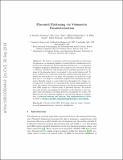| dc.contributor.author | Abulnaga, Sayed Mazdak | |
| dc.contributor.author | Abaci Turk, Esra | |
| dc.contributor.author | Bessmeltsev, Mikhail | |
| dc.contributor.author | Grant, P. Ellen | |
| dc.contributor.author | Solomon, Justin | |
| dc.contributor.author | Golland, Polina | |
| dc.date.accessioned | 2020-12-21T16:10:51Z | |
| dc.date.available | 2020-12-21T16:10:51Z | |
| dc.date.issued | 2019-10 | |
| dc.identifier.isbn | 9783030322502 | |
| dc.identifier.isbn | 9783030322519 | |
| dc.identifier.issn | 0302-9743 | |
| dc.identifier.issn | 1611-3349 | |
| dc.identifier.uri | https://hdl.handle.net/1721.1/128872 | |
| dc.description | Part of the Lecture Notes in Computer Science book series (LNCS, volume 11767). | en_US |
| dc.description.abstract | We present a volumetric mesh-based algorithm for flattening the placenta to a canonical template to enable effective visualization of local anatomy and function. Monitoring placental function in vivo promises to support pregnancy assessment and to improve care outcomes. We aim to alleviate visualization and interpretation challenges presented by the shape of the placenta when it is attached to the curved uterine wall. To do so, we flatten the volumetric mesh that captures placental shape to resemble the well-studied ex vivo shape. We formulate our method as a map from the in vivo shape to a flattened template that minimizes the symmetric Dirichlet energy to control distortion throughout the volume. Local injectivity is enforced via constrained line search during gradient descent. We evaluate the proposed method on 28 placenta shapes extracted from MRI images in a clinical study of placental function. We achieve sub-voxel accuracy in mapping the boundary of the placenta to the template while successfully controlling distortion throughout the volume. We illustrate how the resulting mapping of the placenta enhances visualization of placental anatomy and function. Our implementation is freely available at https://github.com/mabulnaga/placenta-flattening. | en_US |
| dc.description.sponsorship | NIH/NIBIB/NAC (Grant P41EB015902) | en_US |
| dc.description.sponsorship | NIH/NICHD (Grant U01HD087211) | en_US |
| dc.description.sponsorship | NSF (Grant IIS-1838071) | en_US |
| dc.description.sponsorship | Air Force Office of Scientific Research (Award FA9550-19-1-0319) | en_US |
| dc.language.iso | en | |
| dc.publisher | Springer | en_US |
| dc.relation.isversionof | http://dx.doi.org/10.1007/978-3-030-32251-9_5 | en_US |
| dc.rights | Creative Commons Attribution-Noncommercial-Share Alike | en_US |
| dc.rights.uri | http://creativecommons.org/licenses/by-nc-sa/4.0/ | en_US |
| dc.source | arXiv | en_US |
| dc.title | Placental Flattening via Volumetric Parameterization | en_US |
| dc.type | Book | en_US |
| dc.identifier.citation | Abulnaga, S. Mazdak et al. "Placental Flattening via Volumetric Parameterization." International Conference on Medical Image Computing and Computer-Assisted Intervention, Lecture Notes in Computer Science, 11767, Springer, 2019, 39-47. © 2019 Springer Nature | en_US |
| dc.contributor.department | Massachusetts Institute of Technology. Computer Science and Artificial Intelligence Laboratory | en_US |
| dc.relation.journal | Lecture Notes in Computer Science | en_US |
| dc.eprint.version | Original manuscript | en_US |
| dc.type.uri | http://purl.org/eprint/type/ConferencePaper | en_US |
| eprint.status | http://purl.org/eprint/status/NonPeerReviewed | en_US |
| dc.date.updated | 2020-12-16T16:36:43Z | |
| dspace.orderedauthors | Abulnaga, SM; Abaci Turk, E; Bessmeltsev, M; Grant, PE; Solomon, J; Golland, P | en_US |
| dspace.date.submission | 2020-12-16T16:36:46Z | |
| mit.journal.volume | 11767 | en_US |
| mit.license | OPEN_ACCESS_POLICY | |
| mit.metadata.status | Complete | |
